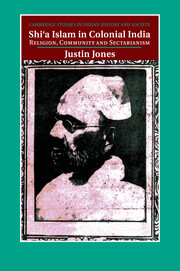Book contents
- Frontmatter
- Contents
- Figures and maps
- Preface and acknowledgements
- Frequently used abbreviations
- Note on transliteration
- Select glossary of terms
- Introduction
- 1 Madrasas, mujtahids and missionaries
- 2 Mosques, majalis and Muharram
- 3 Anjumans, endowments and Indian Shi‘ism
- 4 Aligarh, jihad and pan-Islam
- 5 The tabarra agitation and Shi‘a–Sunni conflicts in late colonial India
- Conclusion and epilogue Shi‘ism and sectarianism in modern South Asia
- Appendix Select Shi‘a ‘ulama of colonial India
- Select bibliography
- Index
- References
1 - Madrasas, mujtahids and missionaries
Shi‘a clerical expansion in colonial India
Published online by Cambridge University Press: 05 November 2011
- Frontmatter
- Contents
- Figures and maps
- Preface and acknowledgements
- Frequently used abbreviations
- Note on transliteration
- Select glossary of terms
- Introduction
- 1 Madrasas, mujtahids and missionaries
- 2 Mosques, majalis and Muharram
- 3 Anjumans, endowments and Indian Shi‘ism
- 4 Aligarh, jihad and pan-Islam
- 5 The tabarra agitation and Shi‘a–Sunni conflicts in late colonial India
- Conclusion and epilogue Shi‘ism and sectarianism in modern South Asia
- Appendix Select Shi‘a ‘ulama of colonial India
- Select bibliography
- Index
- References
Summary
The late nineteenth and early twentieth centuries were, paralleling simultaneous developments within other Muslim communities, a period of major transformation within Indian Shi‘ism. This chapter, the first of two to interrogate the aforementioned ‘fresh religious life’ within Shi‘ism, explores several aspects of Shi‘a clerical and lay religious expansion. Early sections examine the bureaucratization of religious learning through the expansion of madrasa education, and the reworking of the public role of the senior ‘ulama. Later sections turn away from this focus on the ‘formal’ clerical milieu towards the powerful, and often more diffuse, efforts at lay propagation in the early twentieth century, looking at engagement with printing technology and the language of religious proselytization (tabligh). Throughout, the chapter stresses how Shi‘ism, previously identified with an amorphous blend of sayyid cultural norms, doctrinal orientations and religious observances, was gradually articulated as something approximating a reconceptualized religion, one of objective relevance to a broad constituency of followers (mominin) as well as its sayyid spokesmen and public leaders. Later sections turn towards another facet of this expansion of religious knowledge, namely the growth of inner-Islamic religious polemic (munazara). The chapter thus interrogates the question of why the processes of religious proselytization (tabligh) and disputation (ikhtilafat) within Shi‘ism were apparently so functionally intertwined as to be often indistinguishable.
The formation of shi‘a madrasas in colonial India
As has been described in much scholarship, the late nineteenth century witnessed the foundation of numerous madrasas across the United Provinces, whether the dar-ul-‘ulum at Deoband (1867) and the various seminaries created across north India in its image; the Nadwa’t ul-‘Ulama (established as a madrasa in 1898) as well as equivalent ‘Barelwi’ schools such as Misbah ul-‘Ulum (Mubarakpur, 1898) and Manzar-i-Islam (Bareilly, 1904). Some literature on these Sunni religious schools in India has interpreted them as linking India into transnational patterns of Arabic learning, and facilitating communication between Indian ‘ulama and global scholarly networks. Other studies have emphasized instead the impact of these madrasas within the Indian subcontinent itself, describing their creation of an indigenous clergy and their contributions to processes of Islamic renewal (tajdid) within a South Asian framework. Less frequently remarked upon is the foundation of a striking number of Shi‘a madrasas, especially in Lucknow, from 1889 onwards. These schools show a similarly multi-faceted impact, at once connecting the Indian Shi‘a with scholarly traditions observed in the wider world, but also creating a much enlarged body of Indian ‘ulama and the educational infrastructure for sustaining it on Indian soil. Emerging Shi‘a seminaries bore comparison with their Sunni counterparts in important ways: the formation of a recognized and ordered nisab (curriculum), the dispensation of agreed and distinguished qualifications of learning, and the dissemination of education across the ties of kinship and locality.
- Type
- Chapter
- Information
- Shi'a Islam in Colonial IndiaReligion, Community and Sectarianism, pp. 32 - 72Publisher: Cambridge University PressPrint publication year: 2011



